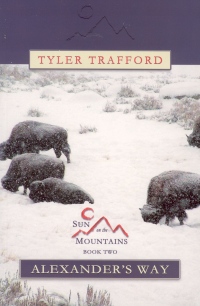| ________________
CM . . .
. Volume XIII Number 5 . . . .October 27, 2006 
 |
Alexander’s Way. (Sun on the Mountains Book Two).
Tyler Trafford.
Saskatoon, SK: Thistledown Press, 2006.
301 pp., pbk., $21.95.
ISBN 1-897235-06-2.
Subject Heading:
Quakers-Fiction.
Grades 9 and up / Ages 14 and up.
Review by Thomas F. Chambers.
** /4
|
| |
|

excerpt:
An irregular ran to the crowd, his gun lifted. Seeing Washington beside Alexander, he lowered the gun. Washington signaled for him to come closer. He hesitated. Washington signaled again and he marched through the officers and stood at attention, his face red, his eyes darting between Alexander and the general.
"How did this man get through the pickets?" Washington demanded, pointing to Alexander.
"He galloped, sir. Straight through. We couldn't stop him."
Washington frowned. "Are you saying an unarmed man, riding without a saddle, galloped into our camp and knocked me from my horse?"
"His black is a very fast horse, sir."
"Apparently," Washington commented.
The irregular stared at Washington, unable to reply.
Alexander’s Way is the second volume in Tyler Trafford's “Sun on the Mountains” trilogy. Volume one, The Story of Blue Eye deals with the North American Plains Indian horse culture. Volume two tells the story of a Quaker, Alexander James, who is exiled to Canada by George Washington during the American war for independence and ends up as a horse trader in western Canada. It is a fictional history, told in the form of a novel. James' (not his real name) descendants did not want their family's name revealed because "we're not that important."
Alexander’s Way is based on journals kept by Alexander with the addition of fictional material to prevent anyone from discovering the family's true identity. The journals were given to Trafford in a Calgary office by one of James' descendants whose identity remained anonymous. He was not to remove the journals from the office, and, when he returned after completing the story, the office was empty.
The anonymity of the person Trafford met and the circumstances surrounding the journals add an aura of mystery to Alexander’s Way. Because it combines fiction with an historical journal, the book is an example of historical fiction. It has, however, no references, which reduces its value as a work of history. A few references dealing with the American Revolutionary War and the natives of the western plains would have been useful.
Trafford also makes what seems to be a serious mistake in telling of James' exploits near Hudson Bay. Travelling west of York Factory, in what became northeastern Manitoba, he came across members of the Dene nation. This is most unlikely because the closest Dene live west of Lake Athabaska in northeastern British Columbia. Most are located in the Mackenzie River Valley.
He also contradicts himself occasionally as shown in the following example. Alexander marries a Nahathaway woman, First Snow, who Trafford writes "had never seen a horse before." Later, he says, "the Nahathaway think horses are only useful as pack animals."
After serving under Washington for five years in the Continental Army, James sailed to England and then to Hudson Bay where he lived with the Nahathaway. One day, while he was on a visit to York Factory, a Hudson Bay Company trading post, Continental soldiers arrive and try to arrest him. This is hard to believe. Would Washington's soldiers have followed James from Virginia to London and then to Hudson Bay in order to claim a reward? How would they have known his whereabouts?
Author Tyler Trafford had several interesting careers before becoming a writer. These include ranching, construction, investing and journalism. Prior to Alexander’s Way, he published ten books. In telling James' story, Trafford introduces the reader to the pacifist philosophy of the Quakers as well as much of the Plains' Indian culture. The coverage of both is well done and very interesting. The addition of references for those wishing to learn more would have been helpful.
Alexander’s Way has no teaching aids and no index. The addition of maps of northern Canada where James travelled, showing the tribal lands of the natives he met, would have added greatly to the book's value. So, too, would illustrations of a teepee and travois and other items of native culture mentioned.
In spite of the dramatic events James experienced, Trafford's telling of his story is not that exciting. Alexander’s Way should be a book one cannot put down. It isn't. Revolution, war, and exile to a strange land come across as ordinary events, not as the momentous ones they were to James.
Recommended.
Thomas F. Chambers, a retired college teacher, lives in North Bay, ON.

To comment
on this title or this review, send mail to cm@umanitoba.ca.
Copyright © the Manitoba Library Association. Reproduction for personal
use is permitted only if this copyright notice is maintained. Any
other reproduction is prohibited without permission.
NEXT REVIEW |
TABLE OF CONTENTS FOR THIS ISSUE
- October 27, 2006.
AUTHORS |
TITLES |
MEDIA REVIEWS |
PROFILES |
BACK ISSUES |
SEARCH |
CMARCHIVE |
HOME |
